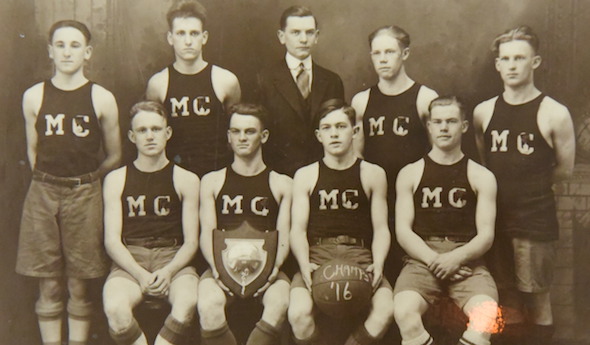
Michigan HS Hoops Celebrate a Century
By
Ron Pesch
MHSAA historian
February 27, 2016
Today we know the campus, and the buildings and playing fields it contains, as Eastern Michigan University. But 100 years ago, the grounds were known as Michigan State Normal College.
On an unusually warm 2016 February day, down on the court of Eastern’s Convocation Center, the Eagles of Eastern and the University of Toledo Rockets warmed up for tip-off. Standing near the doorway of a suite, above the action, Chris Ming, athletic director at Marine City High School, showed off an oak plaque, adorned with a beautiful silver shield featuring a basketball design in relief.
“I can tell you, they don’t make them like this anymore,” Ming said.
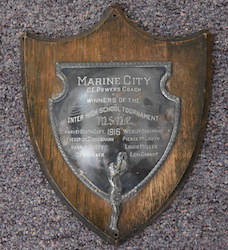 At halftime, Ming and five other representatives from Michigan high schools met at center court to celebrate an event that had occurred a century ago on this campus. In March 1916, around 100 students total representing 12 high schools traveled to Ypsilanti to participate in what has been billed as the first organized high school basketball tournament in Michigan.
At halftime, Ming and five other representatives from Michigan high schools met at center court to celebrate an event that had occurred a century ago on this campus. In March 1916, around 100 students total representing 12 high schools traveled to Ypsilanti to participate in what has been billed as the first organized high school basketball tournament in Michigan.
Historically speaking, the college was a perfect location for that tournament.
“In 1894 the Michigan State Normal College in Ypsilanti had started a new major in physical education. (Professor) Wilber Bowen was appointed chairman of that program,” wrote Dr. Erik (Rick) Pedersen, Professor Emeritus from EMU’s School of Health Promotion & Human Performance in a 2006 article for the Ypsilanti Historical Society. “Bowen had met James Naismith (who developed the game of basketball in 1891 at Springfield College in Massachusetts) through their involvement with the American Association for the Advancement of Physical Education in the late 1880's and early 1890's. To meet the needs of a new major program, the college had also completed construction of a new gymnasium in April of 1894. Bowen was looking for ideas to help with the dedication ceremony of the new gymnasium and recognition of the new major program. Consequently, arrangements were made to have the first basketball game played west of the Allegheny Mountains on May 18th, 1894, in Ypsilanti, Michigan.”
According to newspaper articles covering the 1916 high school tournament, the goal of the event was to arouse “greater interest in basketball in the smaller schools.” Around 300 invitations were sent out to high schools across the state having enrollments of “less than 200 students to take part in a basketball tournament.” It was through the efforts of the college’s Men’s Union, with cooperation from the Athletic Department, that the tournament was organized. According to the 1916 Michigan State Normal College yearbook, Aurora, the tournament also had a second goal. Acting in the best interests of the college, the Men’s Union wanted to showcase the “advantages offered at the Normal” in hopes of attracting future enrollment.
Enrollment at the time was fewer than 2,000 students. The college was the nation’s first teacher-training school to offer a four-year degree, and enrollment was dominated by females. The Men’s Union was formed in 1914 with the stated goal of bringing the male student body together socially, and to work toward recruiting more men to the college.
“Expenses related to transportation, room, and board (for the tournament) had to be provided by the participating schools,” noted Pedersen prior to the 2016 centennial gathering. “The Michigan State Normal College's Physical Education Department made it easier for schools to participate by making arrangements with local residents to provide food at 20 to 25 cents a meal and lodging at 25 cents a night for each player.”
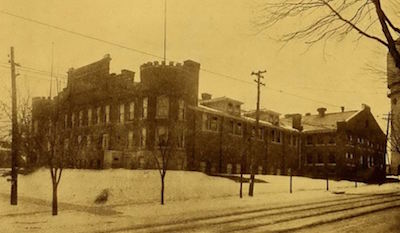 As things fell into place in Ypsilanti, awards were purchased, and prior to the contests, the trophies were placed on display at The Rowima Company, a general store near the school, to help build excitement for the games. It was also announced that players of the winning team would receive individual medals.
As things fell into place in Ypsilanti, awards were purchased, and prior to the contests, the trophies were placed on display at The Rowima Company, a general store near the school, to help build excitement for the games. It was also announced that players of the winning team would receive individual medals.
“The event is the first of its kind in the state and will be made an annual affair,” it was stated in the Daily Ypsilantian Press prior to the start of the tournament. “It is the aim to have larger high schools included in the contest if the affair is a success and as interest develops a more extensive list of prizes will be arranged. A small admission will be charged for each session which will include three or four games.”
Spread over three days, March 23 – March 25, sessions were scheduled for 7:30 on Thursday evening, 9:30 a.m., 1:30 p.m. and 7:30 p.m. on Friday, and Saturday at 9 in the morning and 1:30 in the afternoon at the Normal college gymnasium.
By Saturday afternoon, Dundee and Marine City had emerged as the tournament’s top teams, with 5-1 records, forcing a title game.
“Half the town turned out Saturday night to welcome the victorious basketball team home from Ypsilanti,” wrote a reporter for the Port Huron Times-Herald following Marine City’s thrilling 23-22 victory in the title game. “The silver shield, a trophy of the state championship, was proudly displayed by Coach Powers and every boy was glad to show his own individual (silver) medal.”
With a second-place finish, Dundee was awarded a handsome silver cup, while Milan, Mancelona and Farmington each received a banner in the Normal school colors of green and white, signifying a three-way tie in the tournament for third. Teams from East Lansing, Elkton, Middleville, Mount Clemens, Royal Oak, Saline, and Wayne also competed in the event. Teams were eliminated from play after two losses.
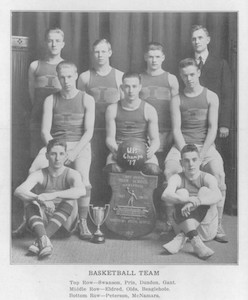 “… It was a great day for Marine City when her team won,” continued the Times-Herald article. “Each member of the high school can take credit for the victory as the money to defray the expenses of the clash was earned in a series of inter-class games played during the last two weeks.”
“… It was a great day for Marine City when her team won,” continued the Times-Herald article. “Each member of the high school can take credit for the victory as the money to defray the expenses of the clash was earned in a series of inter-class games played during the last two weeks.”
Conversations about the use of tournaments to identify a state basketball champion in Michigan had been kicked around in years past.
“As long as teams journey about the state taking on different teams, making a fairly good showing and then trying to win titles by arguments based on comparative scores, all that will result in argument and three or four champions,” stated coach Edbert C. Buss of Detroit Central High School in a 1914 article in the Jackson Citizen Patriot. “The only way I can see to settle the title on the proper team and make it undisputed is by dividing the state into three sections, an eastern, western, and northern district.”
After determining district champions, Buss suggested then a state tournament at a central location to identify a true state champion.
Teams in the Upper Peninsula of Michigan staged basketball tournaments as early as 1913, with Ishpeming claiming the U.P. crown that winter.
“Calumet claims an Upper Peninsula title for 1914,” said Robert Erkkila, a U.P. historian from the city. “We’ve never claimed it to be a state championship.” Yearbooks attest to the fact, indicating they beat Ishpeming 24-21 in the U.P. tournament hosted at the Ishpeming YMCA. “While (Notre Dame legend) George Gipp didn’t spend a lot of time in high school, and never played on Calumet’s football team, he did play basketball, and was on that team,” stated Erkkila.
In January 1917, Northern Michigan Normal College (today, Northern Michigan University) announced plans for the very first U.P. tournament, scheduled for March 2 in Marquette. Michigan State Normal College hosted their second annual tournament, beginning on March 15th, while the University of Michigan and the Michigan College of the Mines in Houghton (known these days as Michigan Tech) scheduled tournaments for the following week.
Again, 12 teams entered the Michigan State Normal College tournament, which still targeted schools with high school enrollment of 200 of fewer.
“Four games of basketball will be played at one time in the state normal gymnasium,” wrote a Flint Journal correspondent, describing Mount Morris’ planned visit to the Normal tournament. “While on this trip the boys will visit the University of Michigan and will do some sight-seeing in Detroit on the trip home.”
“The visiting teams were so well-treated and the tournament was such a success that this year not enough rooms could be found to provide for the teams, and so the offices of the Gym were turned into a veritable dormitory,” recalled the 1917 Normal annual, Aurora.
“The games were all played in quarters with a minute rest between quarters and ten minutes rest between halves,” added the Journal correspondent following the tournament. “The (Mount Morris) boys were accorded a splendid time, given free use of the swimming pool, shower baths and were treated to a banquet in the gymnasium hall by members of the faculty of the State Normal College Friday evening.”
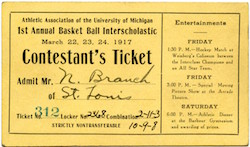 Grayling emerged as the winner of the Normal tournament, winning four games over the two-day gathering. With a 49-9 win over Chelsea, the team earned a silver cup, while team members each earned medals. With confidence, the team stayed over, rested for a few days, then entered the U-M tournament, which was open to all schools of the state.
Grayling emerged as the winner of the Normal tournament, winning four games over the two-day gathering. With a 49-9 win over Chelsea, the team earned a silver cup, while team members each earned medals. With confidence, the team stayed over, rested for a few days, then entered the U-M tournament, which was open to all schools of the state.
The interscholastic department of University of Michigan sent out around 250 printed circulars throughout the state, inviting teams to the “first annual inter-scholastic basketball tournament,” according to a January 5, 1917, article in the Flint Journal.
“Michigan’s first interscholastic basketball tournament is to be held in Waterman Gymnasium on March 22, 23 and 24, and replies from high schools of the State indicate that more than fifty quintets will battle through an elimination series for the State High school championship,” stated the February 1917 edition of The Michigan Alumnus. “This is the first time the University Athletic Association has attempted such a tournament and in view of the fact that Michigan is to have a Varsity basketball five next winter, the inauguration of the high school tourney this year becomes especially important.”
A recent enlargement of Waterman made the tournament possible. With four available courts, it was felt that the tournament could handle more than 60 teams and still be run in three days.
In total, the final field totaled 39 teams from 38 schools including squads from both peninsulas. Detroit Northwestern entered two teams, both coached by Bert Maris. The field was broken into four divisions.
“The meet is expected to result in a more satisfactory settlement of the scholastic championship than has been possible heretofore and to interest promising high school athletes in the University,” noted the March edition of the Alumnus.
The Michigan fraternities hosted the high school players during their stay with “a variety of entertainment … prepared to fill the odd hours,” including a hockey game at Weinberg Coliseum and a moving picture show at the Arcade Theater on Friday. A big dinner was planned for the final night of the tournament at the Barbour gymnasium, “at which the various cups and medals will be awarded,” according to the Alumnus. “The high school men were given the chance to get acquainted with University life and Michigan life in particular.”
“Three hundred high school players and coaches descended on the campus, and in a scene of mass confusion, 17 games were played on the first day alone,” wrote the late Dick Kishpaugh, historian for the MHSAA for 50 years. “Eventually, Detroit Northwestern, coached by Bert Maris, defeated Jackson, 24-21, to capture what virtually all observers at the time recognized as the first true state boys’ basketball champion.”
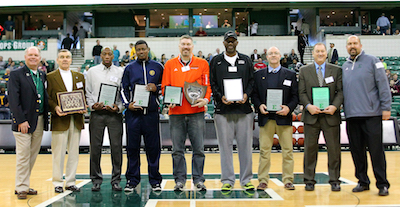 In 1918, the Michigan State Normal tournament marched on for a third year, with 16 teams participating. The title was won by Milan, with Grayling finishing second. World War I halted the University of Michigan’s plan to repeat the format of 1917. However, the desire to find a champion among the state’s larger schools saw the state’s top teams, Kalamazoo Central and Detroit Central, travel to Ann Arbor for a special one-game championship contest. The teams had split two previous meetings that year. The rubber match, and hence the title, was won by Kalamazoo 26-18.
In 1918, the Michigan State Normal tournament marched on for a third year, with 16 teams participating. The title was won by Milan, with Grayling finishing second. World War I halted the University of Michigan’s plan to repeat the format of 1917. However, the desire to find a champion among the state’s larger schools saw the state’s top teams, Kalamazoo Central and Detroit Central, travel to Ann Arbor for a special one-game championship contest. The teams had split two previous meetings that year. The rubber match, and hence the title, was won by Kalamazoo 26-18.
“Just who was in charge of the tournaments was the subject of heated debates in the early years,” Kishpaugh added. “High school administrators and the University of Michigan shared the responsibility in 1917 and 1918, but then (Michigan Agricultural College) wanted a piece of the action, and the finals were moved to East Lansing in 1919.”
That year, competition was divided into two, Class A for the larger schools and Class B for the smaller ones, setting a precedent for class competition which has been the hallmark of Michigan tournaments ever since.
In 1920, the predecessor to the MHSAA, a group called the Michigan Interscholastic Athletic Association, headed by high school administrators, took control of prep athletics and the tournament. Among their first actions was to split the finals between Ann Arbor and East Lansing each year. That year, Class A championship games were played at U-M in Ann Arbor, while Class B games were hosted at M.A.C. in East Lansing. Sites were reversed in 1921. The addition of Class C, segmenting the tournament further, came in 1922, and those games were played in the same city as Class B. The pattern was followed until 1926.
When the present Michigan High School Athletic Association was formed in the fall of 1924, Alden W. (Tommy) Thompson was hired on a full-time basis as State Director of the sport. Every tournament since 1925 has been under the direction of the MHSAA. In 1926, Class D was added, forming the approach taken to naming basketball champions in Michigan that we still use today.
 Ron Pesch has taken an active role in researching the history of MHSAA events since 1985 and began writing for MHSAA Finals programs in 1986, adding additional features and "flashbacks" in 1992. He inherited the title of MHSAA historian from the late Dick Kishpaugh following the 1993-94 school year, and resides in Muskegon. Contact him at [email protected] with ideas for historical articles.
Ron Pesch has taken an active role in researching the history of MHSAA events since 1985 and began writing for MHSAA Finals programs in 1986, adding additional features and "flashbacks" in 1992. He inherited the title of MHSAA historian from the late Dick Kishpaugh following the 1993-94 school year, and resides in Muskegon. Contact him at [email protected] with ideas for historical articles.
PHOTOS: (1) The Marine City boys basketball team won the inaugural high school basketball tournament at Michigan State Normal College. (2) A plaque commemorating the achievement hangs at the school. (3) The gymnasium at what is now Eastern Michigan University hosted the event. (4) Ishpeming won the first basketball tournament played in the Upper Peninsula. (5) University of Michigan hosted a tournament for schools of all enrollments in 1917. (6) Representatives of schools that played in the 1916 tournament at Michigan State Normal College receive plaques during a game this season at EMU. (Top five photos collected by Ron Pesch; bottom photo by Jonathan Knight.)
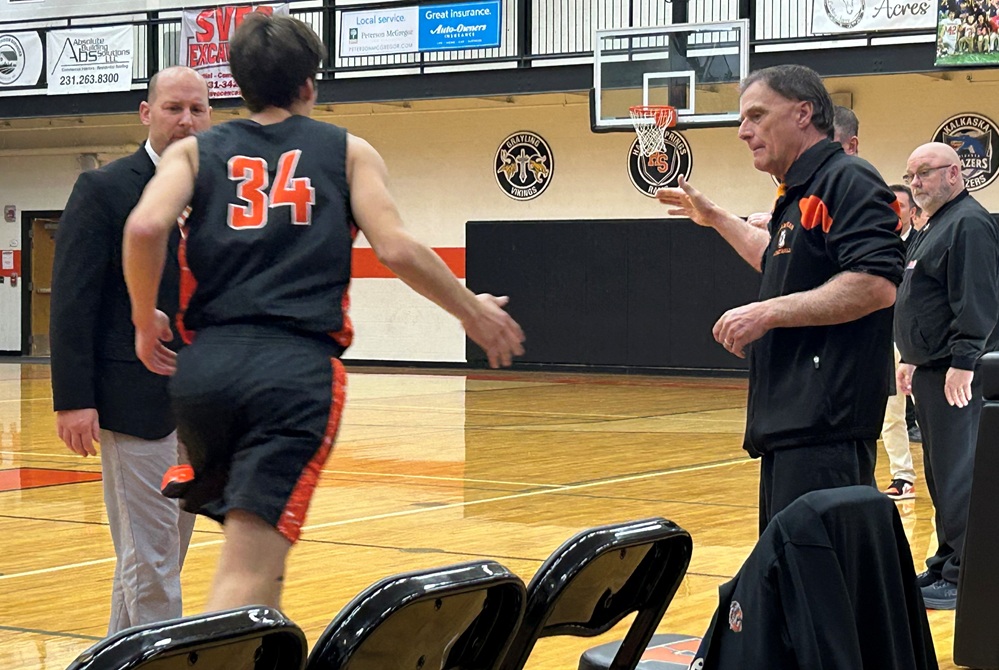
'Scott Hancock Court' Celebrates JV Coach's 50 Years Building Up Cheboygan Hoops
By
Tom Spencer
Special for MHSAA.com
December 19, 2025
It’s been a remarkable season so far for the Cheboygan boys basketball players and coaches.
 The undefeated varsity Chiefs are looking ahead to the new calendar year and their next opponent, Northern Shores Conference rival Elk Rapids. They also have the District tournament they’ll be hosting in February in their sights.
The undefeated varsity Chiefs are looking ahead to the new calendar year and their next opponent, Northern Shores Conference rival Elk Rapids. They also have the District tournament they’ll be hosting in February in their sights.
But Scott Hancock is already looking ahead to the classes of 2035, 2036, 2037 and 2038. And nobody can blame him.
Hancock, a 1976 graduate of Cheboygan, has no intentions of ending his coaching career soon. He’d like to make it long enough to coach his youngest grandson Lincoln Hancock, who is already playing youth basketball in Cheboygan.
And while the Chiefs are finding success this year with the foundation Hancock helped build, the veteran coach can’t help but dream about his youngest grandson playing at Cheboygan High School.
“As a kindergartner he’s in Saturday basketball, and he loves the game,” Hancock said. “God willing, I plan to be there for him.”
Hancock is his 50th season in Cheboygan program. He enjoyed the opportunity to coach his two sons Nick and Brian, both school record holders. He’s also enjoyed coaching his grandson, Landon Gahn, the Chiefs’ junior point guard. Gahn played junior varsity for Hancock his freshman year and moved up to the varsity his sophomore season.
All but two of Hancock’s season were spent as the JV coach. He took the varsity job on an interim basis when current Cheboygan varsity coach, Jason Friday, was playing for the Chiefs in the late 1990s.
On Dec. 9, the Chiefs officially named their home court the Scott Hancock Court. His family was on hand as well as current and former Northern Michigan coaches.
Hancock’s JV team lost that night to Alpena in overtime. The score was 50-50 when the fourth quarter buzzer sounded.
“Looking back, we should have just called the game at the end of regulation,” Hancock admitted. “I got a bunch of great kids this year. and it was a tough loss because it was an overtime loss.”
 It was the only loss the Chiefs’ JV team has encountered so far this year. But wins and losses are not the focus of Hancock’s level of the program.
It was the only loss the Chiefs’ JV team has encountered so far this year. But wins and losses are not the focus of Hancock’s level of the program.
“I don't get too carried away with the wins and losses — I know what I'm there for,” Hancock explained. “I'm there to teach the kids to get them ready for the varsity.”
Hancock is considered by many to be the best coach in Cheboygan history. No counter argument can be found among the current varsity players and their head coach.
“He's the best coach that I've ever had — no bias because he's my grandfather,” acknowledged Gahn, who was found cheering from the bench as the Chiefs secured the victory earlier this week at Kingsley. “He teaches everything about basketball, but he doesn't really preach as much as he demonstrates being a good person. Just looking at him and what he does every day, you can just tell he's the guy that's doing everything right, even though nobody's watching.”
Senior Carson Kiefer helped lead the way for Cheboygan's varsity at Kingsley. He scored 12 points, with two 3-pointers. Kiefer credits Hancock for helping him improve his confidence on the court.
“I think he cares more about the person individually outside of sports,” said Kiefer, who is averaging 16 points per game. “It's fitting that he's a JV basketball coach, helping build players’ skills and confidence.”
Kiefer’s twin brother, Andrew, singled out Hancock’s commitment to the school.
“He's not just a school figure,” said Andrew Kiefer, who is averaging just under 12 points per game. “He is not just the coach. He is a community guy all-around.”
The Chiefs varsity is getting strong contributions from their juniors this season. Nolan Schley is averaging 12 points per game, and he’s second on the team in rebounding. And Gavin Smith is leading the team in rebounds and assists, collecting almost 10 boards and four dishes per game.
The Kiefers, Smith and Schley are part of the reason Friday is not surprised by the 6-0 start and seeking a District title for the first time since 2015. The last time Cheboygan won a conference championship was 2020, playing in the Straits Area Conference during Friday’s first season as boys head coach after previously coaching the girls varsity.
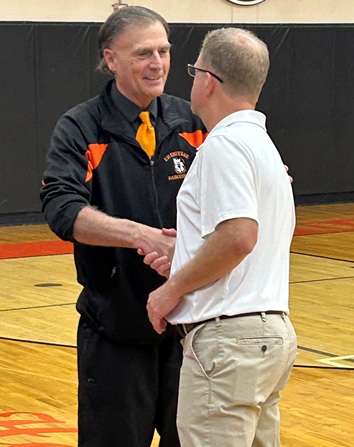 “We knew that our junior and senior classes had some talent in there,” Friday noted. “The boys really want to win a District championship, as well as a conference championship. The boys put a ton of time in the offseason to do everything they can to get over that hump and get both a conference and District championship.”
“We knew that our junior and senior classes had some talent in there,” Friday noted. “The boys really want to win a District championship, as well as a conference championship. The boys put a ton of time in the offseason to do everything they can to get over that hump and get both a conference and District championship.”
Cheboygan will host a Division 2 District tournament this season after falling 50-48 in last year’s Division 3 District Final – also at home. The Chiefs face a field including league foes Grayling, Kalkaska and Kingsley as well as Ogemaw Heights and Sault Ste. Marie. Cheboygan topped the Sault 67-43 earlier this year and will play a home-and-home series with Grayling in January.
For now, though, the Chiefs are thinking only about Elk Rapids. Cheboygan started 7-0 last year before falling to the Elks to start the new year.
“We're approaching 7-0 again, so having them coming up here on the schedule, we’re definitely going to be practicing a little harder and watching maybe a little more film and just preparing for the game more seriously,” Gahn said. “Coach Friday was saying last year that he can't remember the last time the team started off 8-0, and it was our eighth game that we lost to Elks. So we're hoping to beat them next time we play.”
The court naming did not come as a surprise to Hancock. He was informed in a meeting with Marty Mix, Cheboygan principal. He thought he had some papers to sign and was surprised his family was waiting in the office.
“He was completely shocked, and Coach Hancock doesn't like attention,” said Friday, who is also the school’s athletic director and was in the notification meeting. “Scott always likes to be in the background, and he handled it quite well.”
And while his signature was placed on the court opening day this year, he points out the Hancock legacy started way before him.
“I'm more proud of the Hancock name on there more than the Scott part of it,” said Hancock, who also serves as the city’s as the parks and recreation director. “Believe me, my dad was a Chief through and through. He passed in 2006. I know he was there in spirit with us looking down.”
 Tom Spencer is a longtime MHSAA-registered basketball and soccer official, and former softball and baseball official, and he also has coached in the northern Lower Peninsula area. He previously has written for the Saginaw News, Bay County Sports Page and Midland Daily News. He can be reached at [email protected] with story ideas for Manistee, Wexford, Missaukee, Roscommon, Ogemaw, Iosco, Alcona, Oscoda, Crawford, Kalkaska, Grand Traverse, Benzie, Leelanau, Antrim, Otsego, Montmorency, Alpena, Presque Isle, Cheboygan, Charlevoix and Emmet counties.
Tom Spencer is a longtime MHSAA-registered basketball and soccer official, and former softball and baseball official, and he also has coached in the northern Lower Peninsula area. He previously has written for the Saginaw News, Bay County Sports Page and Midland Daily News. He can be reached at [email protected] with story ideas for Manistee, Wexford, Missaukee, Roscommon, Ogemaw, Iosco, Alcona, Oscoda, Crawford, Kalkaska, Grand Traverse, Benzie, Leelanau, Antrim, Otsego, Montmorency, Alpena, Presque Isle, Cheboygan, Charlevoix and Emmet counties.
PHOTOS (Top) Longtime Cheboygan boys basketball JV coach Scott Hancock sends a starter onto the floor during introductions before a game against Kingsley. (Middle) The Hancock family takes a photo with Scott’s newly-added signature on the floor. From left: Landon Gahn, Brian Hancock, Olwyn Hancock, Scott Hancock, Marjean Hancock, Lincoln Hancock and Nick Hancock. (Below) Scott Hancock shakes hands with a Kingsley assistant coach. (Family photo courtesy of Chris Murdick. Other photos by Tom Spencer.)

